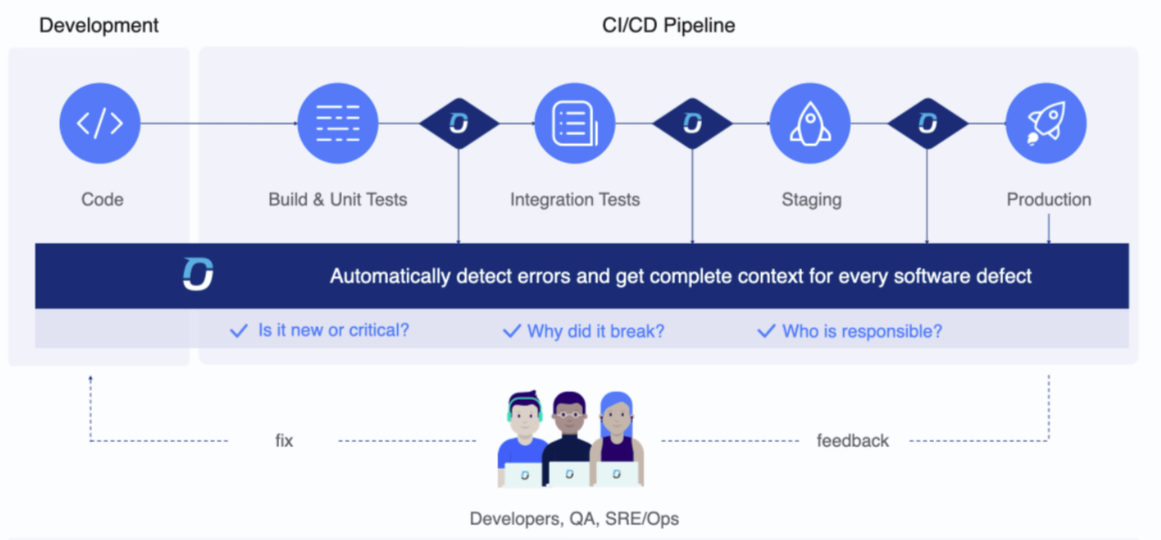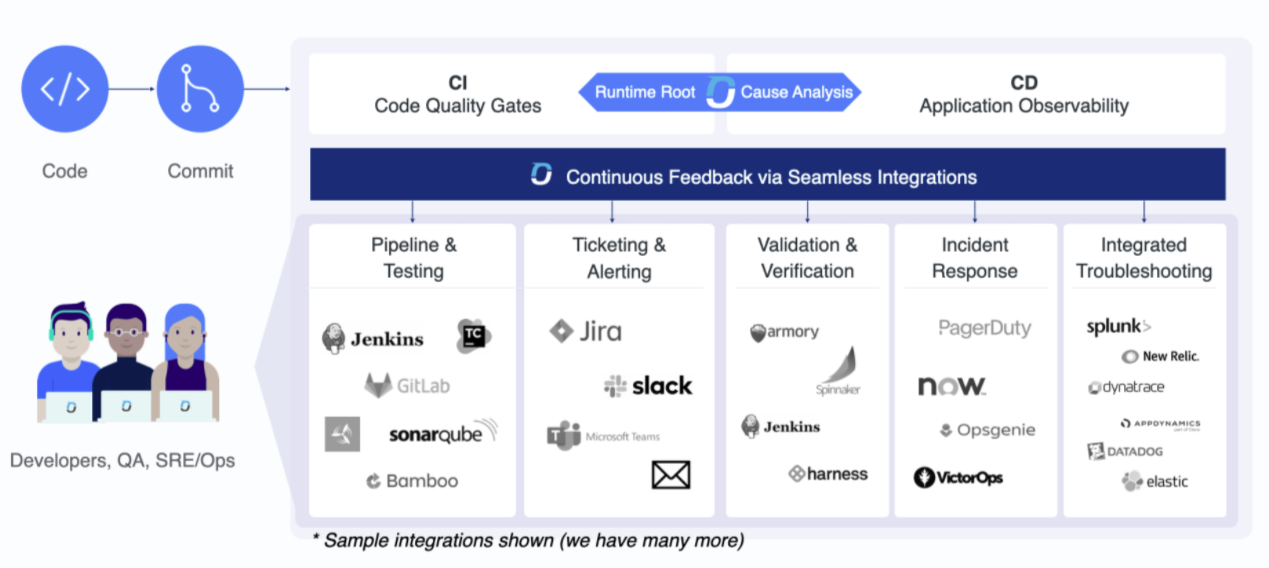This website uses cookies so that we can provide you with the best user experience possible. Cookie information is stored in your browser and performs functions such as recognising you when you return to our website and helping our team to understand which sections of the website you find most interesting and useful.
HOW OVEROPS FITS INTO YOUR
DevOps Stack
OverOps fills a critical role in DevOps: allowing you to instantly pinpoint critical exceptions during run-time, whether in testing or production. This allows innovation to continue without sacrificing quality -- nor without detective work of reproducing critical issues.

Software delivery as a “factory” concept with the DevOps workflow
As a software industry, we are innovating faster, and we are demanded to deliver higher quality software more frequently. Applications are now commonly built on microservices and using Kubernetes. In response to this, the way we approach the design and delivery of software has changed.
The cloud is driving change of course which pushes us to apply “factory” concepts to software. The software industry has created the concept of a “software delivery factory”: a method to plan, implement, and control the efficient, effective storage and flow of software from concept to customer.
This software factory is of course the DevOps team running a CI/CD workflow. And that chain is under ever-increasing pressure for faster releases -- yet with continuing expectations of high quality.
GET STARTEDThe Fastest Way to Why.
Build software
- Collaboration: Slack, Microsoft Teams
- Source control: GitHub, GitLab
- Issue tracking: Atlassian Jira, ServiceNow, Github Issues, Gitlab Issues
- Packaging:Docker
- CI/CD: Jenkins, TeamCity, GitLab CI, Bamboo
Put software into production
- Container Orchestration: Kubernetes, Pivotal Cloud Foundry (PCF), Azure Container Service (ACS), AWS Fargate
Track production software status and troubleshoot issues
- Logs: Splunk, Elastic, Sumo Logic, Scalyr
- APM: AppDynamics, Dynatrace, New Relic
- Monitoring: Datadog, Splunk ITSI, StatsD
- Alerting: Pagerduty
- Visualization: Graphite, Grafana, Kibana

What’s commonly missing in the “software factory”?
Unfortunately, many teams are commonly not yet aware of a critical piece to keep everything running smoothly: root cause analysis for critical issues. That’s where OverOps helps. OverOps instantly pinpoints at runtime -- from development to production -- why critical issues break backend Java and .NET applications, eliminating the detective work of searching logs.
Therefore, engineering teams can then easily identify and resolve critical application exceptions before they pass to the next quality gate -- or before impacting customer experience.
For pre-production and CI pipelines, we help engineering teams shift left. OverOps acts as a quality gate that’s integrated into existing static analysis, testing and CI pipeline solutions, reporting on unknown exceptions and informing go/no-go decisions for new releases.
In production and CD pipelines, we help you shift right, by helping limit the blast radius of new exceptions by proactively detecting issues and capturing the relevant variable context. Integrating with your existing log management and APM solutions, as part of the CD pipeline.

In both cases, OverOps enables an automated feedback loop that’s integrated with logs, APM, ticketing and alerting to deliver rich exception snapshots with source code, variable state, relevant logs, and operational context for every critical exception.
And OverOps plugs in easily to your existing tools. We provide deep, code-level data directly within the tools your teams already use.
Increased innovation without sacrificing qualityUnlike logs, static testing, and APM, that require foresight, OverOps analyzes code at runtime. OverOps requires no code changes, integrates into your existing CI/CD tooling, and does so continuously, from pre-prod through production. That means:
- 70% MTTR REDUCTION: Reproduce production issues fast, driving down MTTR, and ensuring the customer does not get impacted.
- 80% FEWER ESCAPED DEFECTS: Improve quality by detecting critical and unknown defects early and prevent them from reaching your customers.
- 10X IMPROVED PRODUCTIVITY: Stop wasting time troubleshooting to reproduce critical exceptions in test and production, and instead spend that precious time innovating.
How Does OverOps help in each step of the software factory?

- Source control: Github, Gitlab
- How OverOps helps: Git blame support and automated source attach
- Collaboration: Slack, Microsoft Teams
- How OverOps helps: Send exceptions to ticketing and chat solutions with code-driven routing.
- Issue tracking: Atlassian Jira, ServiceNow, Github Issues, Gitlab Issues
- How OverOps helps: Send exceptions to ticketing and chat solutions with code-driven routing.
- Packaging: Docker
- How OverOps helps: Supports both traditional and microservice-based applications.
- CI/CD: Jenkins, TeamCity, GitLab CI, Atlassian Bamboo
- How OverOps helps: Stop bad code from being promoted with runtime quality gates.
- Provisioning, Configuration Management: Chef, Puppet, Ansible, SaltStack
- How OverOps helps: Deploys easily across thousands of microservices.
- Log Management: Splunk, SumoLogic, Elastic/ELK
- How OverOps helps: See the complete state behind every exception.
- Alerting & Visualization: PagerDuty, Graphite, Grafana
- How OverOps helps: Customize your own dashboards with insights from OverOps.
Supercharge your software factory with OverOps
Building the perfect enterprise DevOps stack is about looking at the problem at hand and understanding what ties everything together. When it comes to building and maintaining reliable software, context-rich insights to pinpoint critical exceptions is everything.
Learn how you can supercharge your current software factory workflow with OverOps.
Featured Content for Retail and E-commerce


